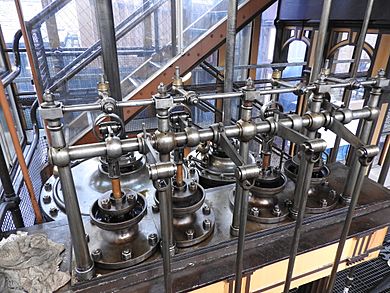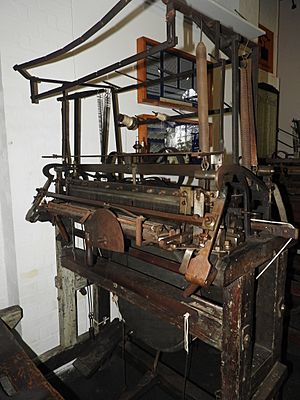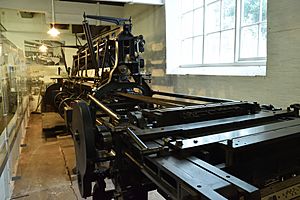Nottingham Industrial Museum facts for kids
The Nottingham Industrial Museum is a special museum in Nottingham, England, run by volunteers. It is located in the old 17th-century stables of Wollaton Hall. The museum shows off Nottingham's amazing history in making things like textiles, cars, and even in mining.
In 2012, the museum won the Nottinghamshire Heritage Site of the Year Award. For a short time, the museum had to close, but it reopened thanks to government help and the hard work of its volunteers. Now, you can visit on weekends and bank holidays to see all the cool inventions and machines from Nottingham's past.
Contents
Why is Nottingham an Industrial City?
Nottingham has a long and busy history. It was settled by Vikings in 867 and later by the Normans, who built Nottingham's famous castle.
For centuries, the area was known for making and dyeing cloth. People also mined coal from the ground nearby. Because it was an important city with a castle, many businesses and industries grew there. This history of making things is why Nottingham has an industrial museum today.
What Can You See at the Museum?
The museum's collections are split into five main areas: Textiles, Transport, Communications, Mining, and Steam power.
Amazing Textiles
Nottingham was a world leader in the textile industry because of two important inventions from the area.
- The Stocking Frame: In 1589, a man named William Lee invented a special knitting machine. It could knit stockings much faster than a person could by hand. Soon, thousands of these machines were being used in homes all around Nottingham. The museum has several of these historic machines.
- The Lace Machine: In 1808, John Heathcoat invented a machine that could make lace just like it was made by hand. This started Nottingham's famous lace industry. Some people, called the Luddites, were afraid these new machines would take their jobs, so they broke into Heathcoat's factory and smashed his machines. After Heathcoat's patent ended, many more lace factories opened in Nottingham. At its peak, the city was the world's center for machine-made lace.
In the museum, you can see many of these incredible machines, including a huge Leavers machine that was built in 1881 and still works today!
Cool Old Vehicles
The transport section has a collection of bicycles from the famous Raleigh brand and powerful Brough Superior motorbikes. Only 3,000 of these motorbikes were ever made in Nottingham. The famous adventurer T. E. Lawrence loved them and owned eight.
You can also see a very rare Celer car and the bicycle that belonged to Thomas Humber, another famous bike maker.
Old-Fashioned Communication
This part of the museum shows how communication has changed over time. You can see radios and gramophones from the 1920s and even hear what they sounded like. There is also a telegraph system where you can try tapping out a message in Morse code.
Mining and Farming Machines
In the museum's yard, you can see a coal truck from a local mine called Clifton Colliery. Next to it is a "living van," which was like a small trailer home for workers who traveled with steam engines for road or farm work.
The yard also has a collection of tractors, including a Standard Fordson and a Field Marshall. On special "steaming days," you can sometimes see these old machines running. There are also smaller "barn engines" that were used to power pumps and other farm equipment.
The Power of Steam
The Steam Gallery is home to the museum's most impressive exhibit: the Basford Beam Engine. This huge engine was built in 1858 to pump fresh water from underground for the people of Nottingham. It was moved to the museum in 1965 and is now a star attraction.
The gallery also has two massive ploughing engines. They were the last two ever made by their company and were used on a large farm. One of them still works and is operated during museum events. You can also see a portable steam engine from 1886 that has been restored to full working order.
More to See
- An operational model railway that runs in the steam hall.
- A huge mill engine that was rescued from a local pub.
- Old clocks and printing machines.
- Items from famous Nottingham companies like Boots the Chemist and Players Cigarettes.
- A carved stone crest from Nottingham's very first railway station, which opened in 1839.





